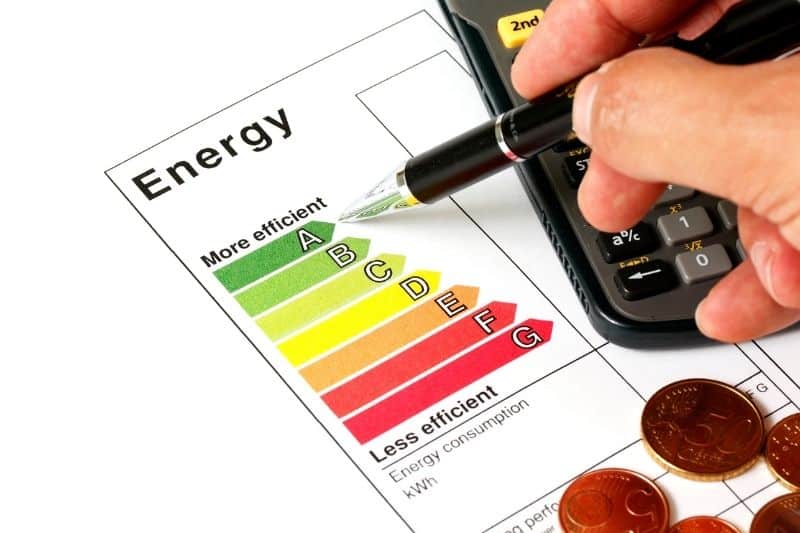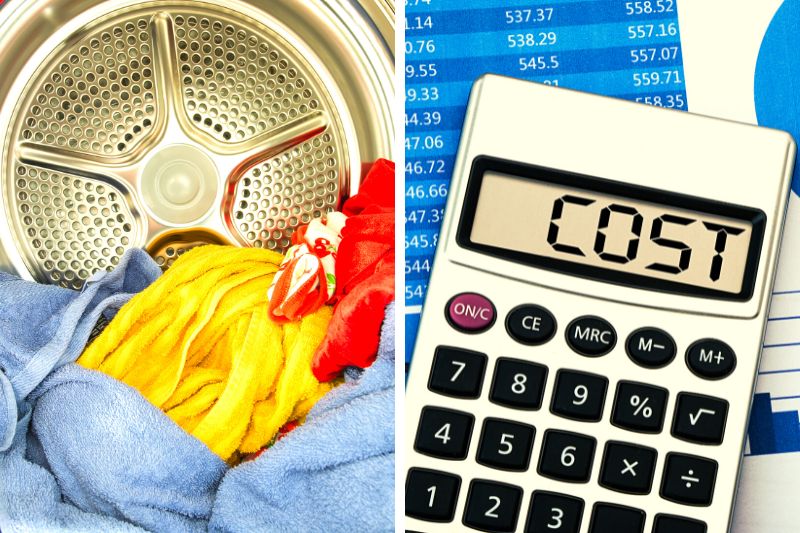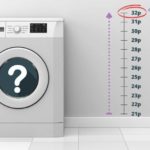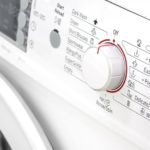Tumble dryers are notorious for being one of the most expensive household appliances to run. So much so that there are households who swear off them entirely.
However, tumble dryers have become increasingly more energy efficient in recent years, which means that this bad reputation isn’t always deserved.
In this article, we’ll be looking at how much running a tumble dryer will add to your energy bill, and which factors affect running costs.
How Much Does it Cost to Run a Tumble Dryer in the UK?
Per cycle
Please note, these figures are based on running a full load of laundry on a cotton cycle, since these are the energy usage figures given by retailers and manufacturers. If you tend to dry lighter loads and/or synthetics, each cycle will be cheaper than the figures below.
Condenser dryers
The average condenser tumble dryer uses roughly 5.1 kWh to run a cotton cycle with a full load.
Based on an average electricity cost of 26.35 pence per kWh for the Energy Price Cap (EPC) period from 1 October to 31 December 2025, a condenser dryer cycle would cost you £1.34.
Vented dryers
The average vented tumble dryer uses roughly 5 kWh to run a cotton cycle with a full load.
Based on an average electricity cost of 26.35 pence per kWh for the Energy Price Cap (EPC) period from 1 October to 31 December 2025, a vented dryer cycle would cost you £1.32.
Heat pump dryers
The average heat pump tumble dryer uses roughly 1.9 kWh to run a cotton cycle with a full load.
Based on an average electricity cost of 26.35 pence per kWh for the Energy Price Cap (EPC) period from 1 October to 31 December 2025, a heat pump dryer cycle would cost you £0.50.
Per hour
The per-cycle figures given above are based on a full-load cotton cycle, which would take around 2 hours 45 minutes on a condenser dryer, 2 hours 30 minutes on a vented dryer, and 3 hours 20 minutes on a heat pump dryer.
However, many tumble dryer cycles only take 40 minutes to an hour, as people tend to dry lighter loads and synthetics, which dry quicker than cotton. Therefore, the cost per hour might be a more useful guide to how much your tumble dryer costs per use.
We used data from Currys.co.uk to calculate the estimated energy usage per hour below.
Condenser dryers
The average condenser dryer uses around 1.85 kWh per hour.
With current electricity prices of 26.35 pence per kWh, this means that running a condenser tumble dryer for one hour will cost £0.49.
Vented dryers
The average vented dryer uses around 1.97 kWh per hour.
With current electricity prices of 26.35 pence per kWh, this means that running a vented tumble dryer for one hour will cost £0.52.
Heat pump dryers
The average heat pump dryer uses around 0.57 kWh per hour.
With current electricity prices of 26.35 pence per kWh, this means that running a heat pump tumble dryer for one hour will cost £0.15.
Per year
Assuming you used your tumble dryer 120 times a year with an average cycle time of one hour for a vented or condenser dryer, and one hour 15 minutes for a heat pump dryer, your annual tumble dryer running costs would be as follows:
- Condenser dryer: £4.90 a month and £58.80 a year to run.
- Vented dryer: £5.20 a month and £62.40 a year to run.
- Heat pump dryer: £1.88 a month and £22.50 a year to run.
However, it’s worth remembering that these figures are just a rough guide, as how much it really costs you will depend on what you dry and how often you use your dryer.
Experts agree that there are a wide range of variables that will influence how much your tumble dryer actually costs you to run.
This includes the energy rating of the tumble dryer, where in your home it is installed, the type of laundry you are drying and the size of the load, to name just a few.
What Affects How Much Tumble Dryers Cost to Run?
1. Energy rating

The energy efficiency rating of a tumble dryer is easily one of the single biggest contributors to its running cost.
The rating scale ranges from A+++ through to E, with A+++ being the most efficient and E being the least.
As you move through the rating scale, the type of tumble dryer you are looking at will change, and this is where you’ll see the biggest cost differences.
More energy efficient models are likely to be heat pump or condenser style dryers, whereas the least efficient models tend to be vented.
2. Drying capacity
A tumble dryer with a higher drying capacity uses more energy per cycle, leading to an increase in annual running costs.
3. Tumble dryer type
There are three main types of tumble dryer: vented, condenser, and heat pump. Heat pump tumble dryers are the most energy efficient and therefore the cheapest to run. However, they do tend to be more expensive to purchase up front.
4. Maintenance
Tumble dryers that aren’t clean or are poorly maintained will just end up costing you more in the long term when compared to a machine that is well maintained.
Something as simple as making sure you clean the lint filter after each cycle can make a world of difference.
How to Keep Your Tumble Dryer Running Costs Down
1. Prioritise efficiency
If you do find yourself in a position where you need to replace your tumble dryer, prioritise efficiency and better energy ratings when you shop around.
Choosing the most energy-efficient tumble dryer might cost you more up front, but you could find yourself saving quite a lot of money in running costs.
2. Dry larger loads rather than individual items
Whilst it might be tempting to have a constant supply of warm socks and towels in winter, drying small loads is not good for your energy bills.
You will find your tumble dryer’s running costs are a lot less if you dry full loads less often than if you dry individual items frequently.
3. Keep washing separated

During the cycle, some people find that it is helpful to use tumble dryer balls (or tennis balls) to separate laundry whilst it is drying. This should help to distribute the laundry better, enabling it to dry through more thoroughly. However, the results people report from this are mixed.
4. Keep the dryer somewhere warm
You might not realise it, but where your tumble dryer is placed can have an impact on how much energy it uses.
If you keep your tumble dryer in a warm room, it will require less energy to warm the air inside the machine up, helping you to cut your energy usage.
Data on Tumble Dryer Energy Usage
To write this article, we used energy cost data from Ofgem and tumble dryer energy usage data from Currys.co.uk.
To calculate average energy usage, we used the models in the table below.
| Model | Type | Energy rating | Cycle length (minutes) | Energy usage per cycle (kWh) | Energy usage per hour (kWh) |
|---|---|---|---|---|---|
| Beko DTKCE80021W 8 kg | Condenser | B | 142 | 4.75 | 2.01 |
| Candy CSE C10DF NFC 10 kg | Condenser | B | 197 | 5.7 | 1.74 |
| Hoover H-Dry 350 HRE HRE C10TE-80 WiFi-enabled 10 kg | Condenser | B | 197 | 5.07 | 1.54 |
| Hotpoint C HD C92 WWGD UK 9 kg | Condenser | B | 149 | 5.22 | 2.10 |
| Indesit C YD C82 WWGL UK 8 kg | Condenser | B | 142 | 4.75 | 2.01 |
| Beko Pro BM3T3822W 8 kg | Heat Pump | A+ | 199 | 2.18 | 0.66 |
| Bosch Series 4 WTH85225GB 8 kg | Heat Pump | A++ | 205 | 1.87 | 0.55 |
| Hisense 3S Series DH3S802BW3 8 kg | Heat Pump | A+++ | 188 | 1.41 | 0.45 |
| Logik LHP8W25 8 kg | Heat Pump | A+ | 209 | 2.18 | 0.63 |
| Samsung Series 5 AI Energy DV80CGC0B0AEEU 8 kg | Heat Pump | A++ | 190 | 1.85 | 0.58 |
| Candy CSEV9LG 9kg | Vented | C | 150 | 5.34 | 2.14 |
| Hoover H-Dry 300 HLE V10DG-80 10 kg | Vented | C | 171 | 6.03 | 2.12 |
| Indesit C YD A81 WWGL UK 8 kg | Vented | C | 155 | 4.84 | 1.87 |
| Logik LVD7W18 7 kg | Vented | C | 145 | 4.49 | 1.86 |
| Montpellier MVSD7W 7 kg | Vented | C | 145 | 4.44 | 1.84 |

In The Wash is your guide to the best laundry and cleaning products, tips and tricks. Our mission is to solve the UK’s cleaning and laundry dilemmas!






